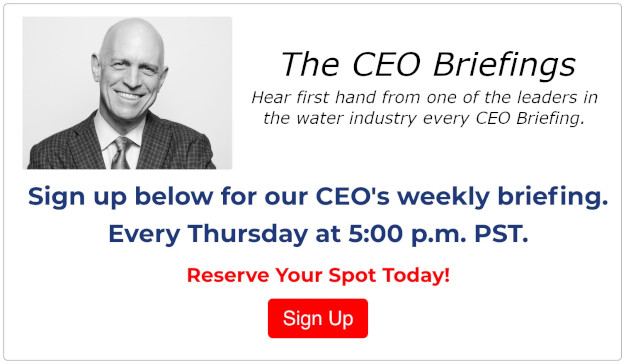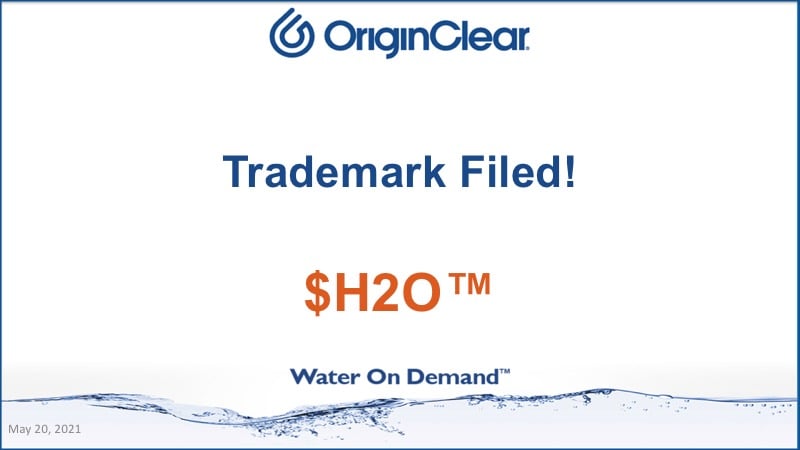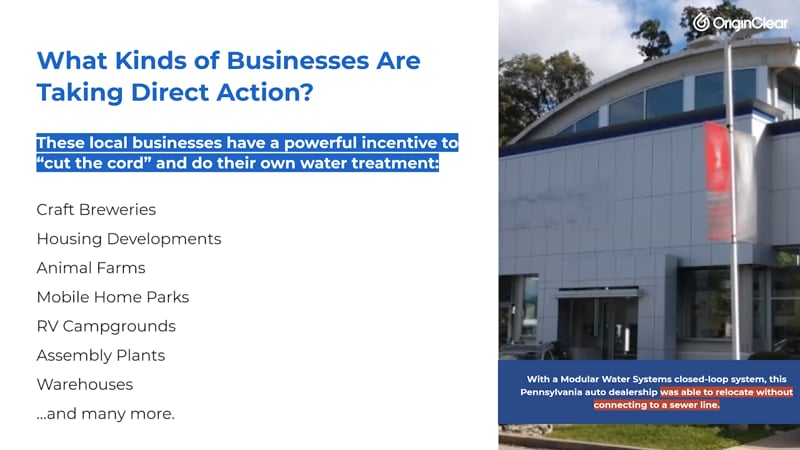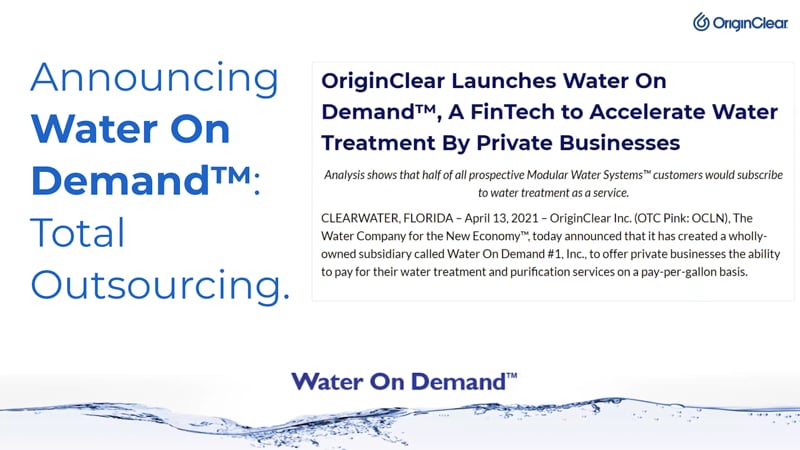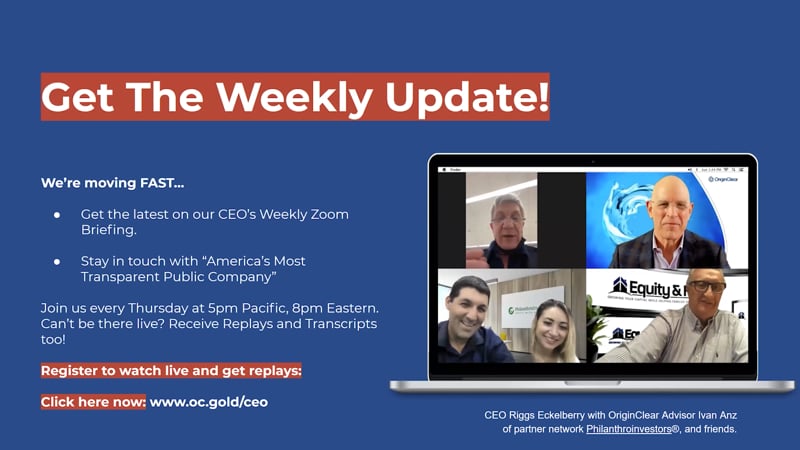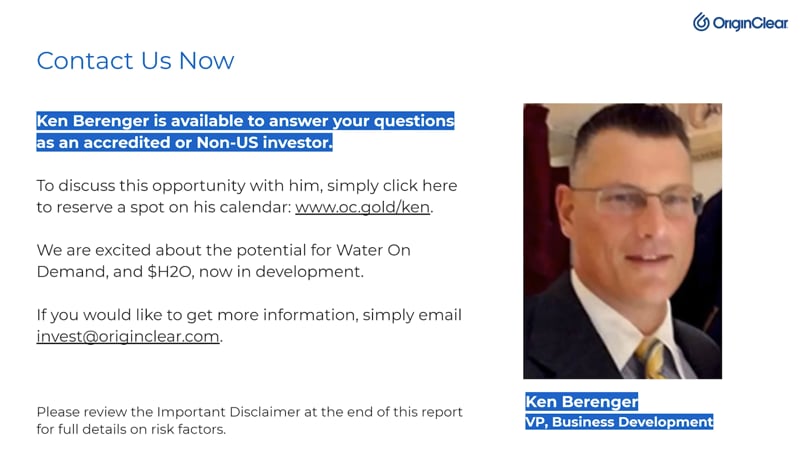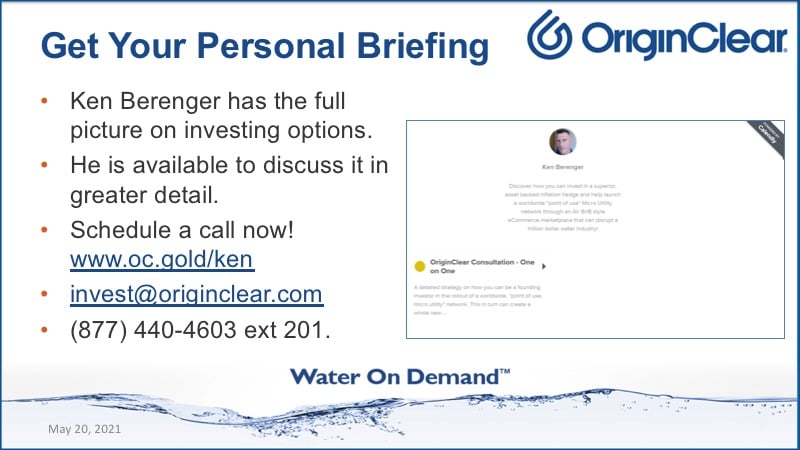Insider Briefing of 20 May 2021
Here’s the First Look at our breakthrough report, "Broken Water — How Can We Help?" We believe this is THE game-changer for water. Check it out! And what about that trademark!! And… get the scoop on Dan’s “magical nano-ceramic biofilm”!
FEATURED/COVERED IN THIS BRIEFING — QUICK LINKS
- A clip of Ivan Anz from a Philanthroinvestors convention in Puerto Rico.
- Our amazing new technology for real estate that handles sediment and nutrients in manmade lakes, ponds, lagoons and stormwater ponds.
- A collage of Progressive Water's impressive products and quality.
- A good news update on recruiting a CFO.
- Our hot new trademark filing.
- The debut of our new presentation: Broken Water - A Worldwide Health Crisis.
- Urban and rural COVID water contamination.
- The effect of runaway inflation on infrastructure projects.
- The solution to our water infrastructure problems.
- Water on Demand and outsourcing water treatment.
- The financial promise of Water on Demand.
- What Water on Demand and Modular Water bring to the scene that is new.
- Digital currency and the potential future marketplace.
- Investing in OriginClear and investment options.
Transcript from recording
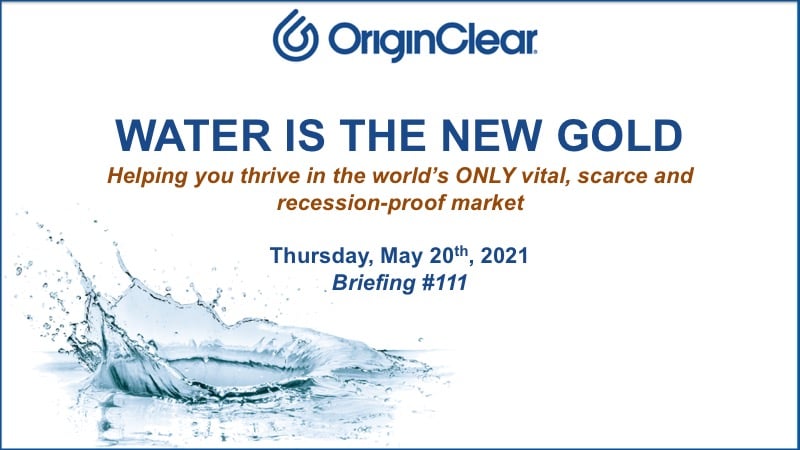
Introduction
Riggs Eckelberry:
Well, hello everyone. Another edition of our exciting briefings, they get more and more exciting all the time and amazing we have Spanish. And so if you click at the bottom globe, if you are a Spanish speaker, you will get real time interpretation in Spanish. All right. Let's get started right away and I'll simply share a screen while people are coming in. Wow. A lot of people joining, this is fantastic. All right.
So this is Water is the New Gold, "Helping you thrive in the world's ONLY vital scarce and recession-proof market." And this is proving to be more and more so. It is Thursday, the 20th briefing number 111.
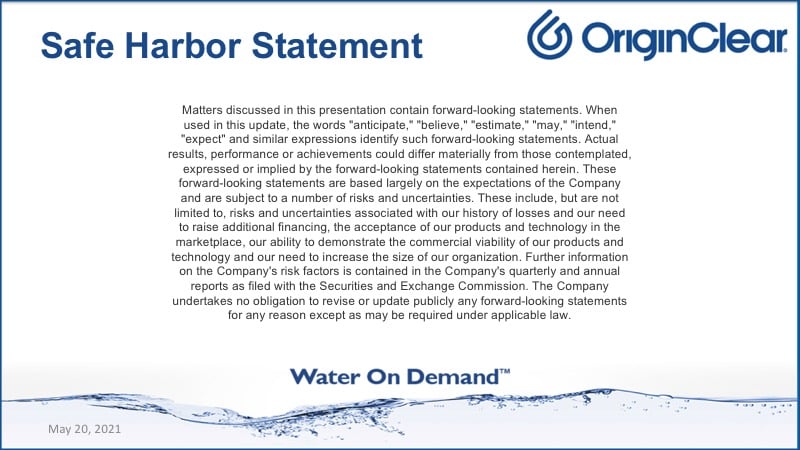
Forward Looking Statements
Okay. So of course, we have the usual safe Harbor statement, which says that we do our very best to tell you like it is, but these are just estimations and they could end up differently. However, we really do try hard to tell you like it is.
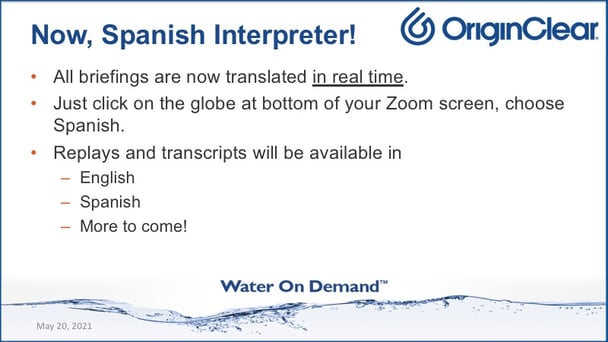
Translations
Okay. As I was just saying all briefings are translated in real time, you just click on the globe at the bottom of your zoom screen, choose Spanish and replays will be available, and the transcripts, I believe will be available in both languages. All right. So now what I'm going to do is I'm going to shift to the media mode, where we have three interesting clips to play. So let's get right into it.
Start of video clip
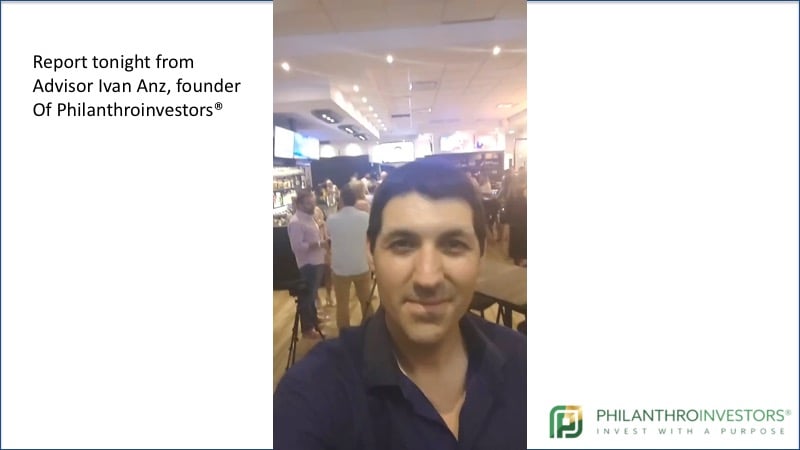
Living a Better Life
Ivan: Hello friends. We are here in Puerto Rico. In an event in Dorado Beach. With high net-worth individuals showing them, how they can invest with a purpose . How they can actually grow their money, while they change people's life. How they can grow their money, while they're actually improving the condition of the planet. Not just money for money. We're here in Dorado Beach in Puerto Rico, with all high net-worth individuals and our VP of expansion, Vendy Rios is also here, I want to show you. Hi!
Vendy: Hi! How's your day?
Ivan: So it's going great, we are going to show investors in Puerto Rico and show how they can be PHILANTHROINVESTORS®. How they can feel the difference. How they can establish living a better life, instead of just money for money. Have a wonderful evening, guys.
End of Video
Riggs: Wonderful.
Next video clip
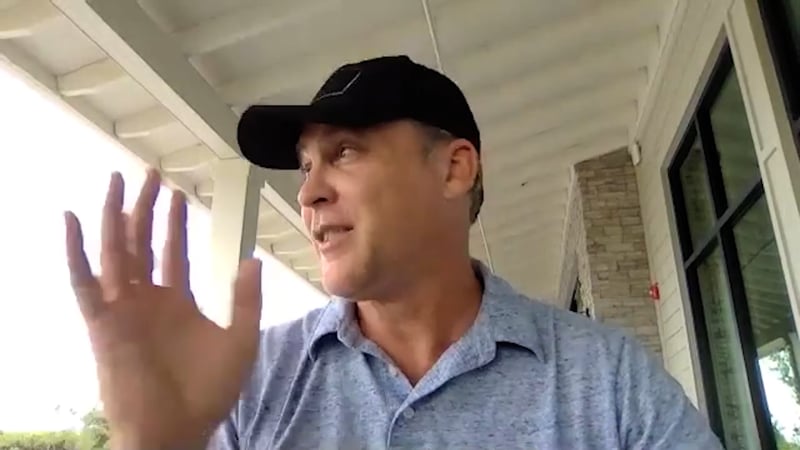
Technology for Real Estate Communities
Tom Marchesello: I love the latest and greatest technology that we've been doing that were specifically for real estate communities. And it presents some interesting opportunities and problems for everybody.
Cause real estate developers are going to make beautiful new homes, in these nice neighborhoods, and they're going to have lakes and ponds and storm water runoff and all these other fun stuff. And so I'm sitting at one right now, which happens to be my house. So when you look out there, Dan-
Dan: I'm jealous Tom.
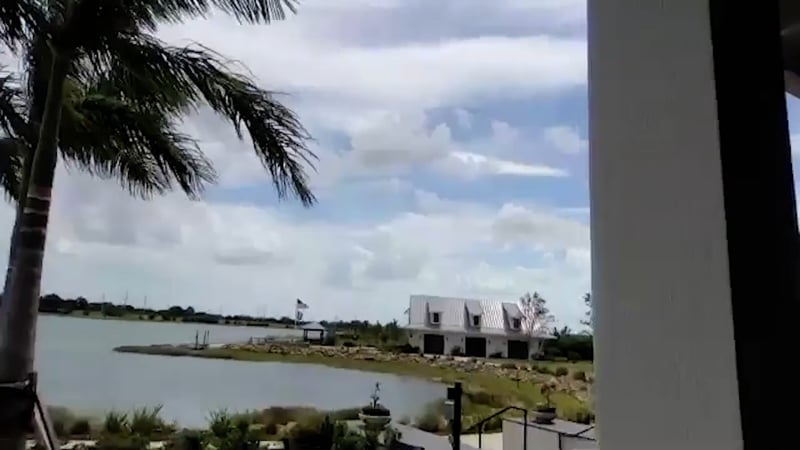
Undiscovered Problem
Tom: I know, but it's actually a man-made lake. Believe it or not.
Dan: Beautiful.
Tom: That's a 40 acre lake, but the ones on the other side of the neighborhood are typically five acre, 10 acre, lots of little, one, two, five acre things. Some are storm water runoff, some are supposed to be beautiful, so you can get the million dollar house put on them and charge the premium. But you and I found an undiscovered problem here in these lakes and a need.
An Aesthetic Becomes a Nuisance
Dan: When you build these manmade ponds, they become repositories for sediments, everything that gets flushed off of the urban landscape. You've got a tramp oils. You've got fertilizers, you've got pesticides. You've got everything that that urban environment has. And it flushes into those bodies of water. Now these stormwater management ponds are designed to collect, retain, and to a certain extent, try to treat that water.
What happens is the first couple of years, pristine looks beautiful. It accomplishes what it's there for. It's an amenity and an aesthetic and the people in the neighbors love it. The neighborhood loves it. But as time marches on, what happens? More and more nutrients get flushed and what happens, it starts stinking. You get algae blooms, you get cyanobacteria, you can get red tides if you're actually in a bay like in and out of the Tampa Bay region. And so now what was an aesthetic now becomes a nuisance.
Technologies that Naturally Remedy
What was an amenity now becomes an albatross. And it is so problematic. It's so problematic in Florida. And in these warmer regions where you have a lot of these stormwater impoundments, the stormwater ponds.
So the one thing that we have worked on through a strategic relationship is that we are developing technologies to go in, and to naturally remedy and treat these impoundments, these ponds and these lakes and these water features and do it energy efficiently, do it all naturally to remove the nutrients, the nitrogen and phosphorus and those types of things.
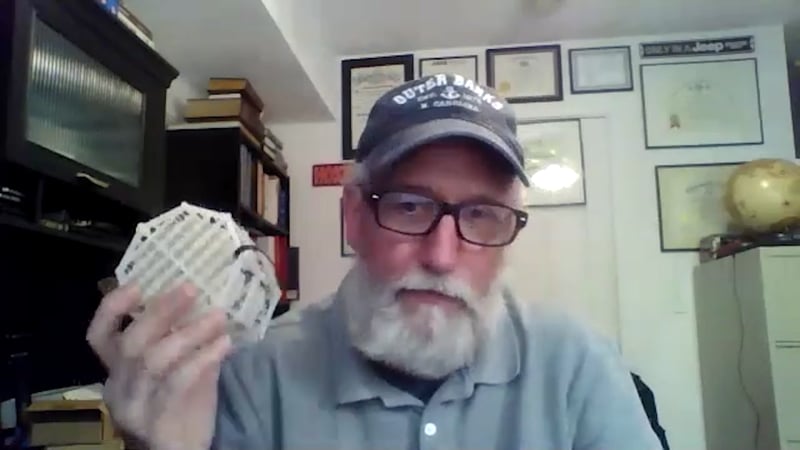
Dan: We are going to take. We're going to implement this biological fixed-film component.
Video paused for commentary
Riggs: This is ceramic biofilm and you can liken it to putting coral in the water where literally you have these incredible amounts of surface area. This is technology that we are almost the sole provider of. We have a pipeline to a partner that is just amazing.
And this is the secret to what we call the Pondster™ technology. We previously called it the Bio Buoy, if you were around for that, and this is what we're implementing to, colonies of bacteria live on these ceramic surfaces, which have all these little cracks. Literally it probably adds up to thousands of miles of surface area in there and that bacteria-
Leveraging Biological Capability
Dan: In a specifically engineered approach where we are leveraging this enormous biological capability to remove residual carbon. We can take ammonia, which is toxic in the environment, and we can convert that to nitrate and we can do it in a single step. And we can treat the same quantity of water, at probably about 2% of the electrical demand. And why is that? It is leveraging the inherent biological efficiency of the microorganisms that would live inside the porous media.
Fits in the Back of a Pickup
What is really cool about this Tom, is that we created these modules. It would fit in the back of a pickup truck. It's how small one of these modules would be. And it would be freestanding, self-supporting. You lower it down into these big concrete tanks where the pig lagoons, the pig manure and all this stuff is concentrated, put it under aeration. And you allow the natural world and the microbiological world to do what it does best.
No Chemicals
Tom: You basically get to make my ponds and lakes and storm water ponds, clean, healthy, and fresh. In an end, you don't use chemicals.
Dan: That's right, we don't want to heap problems on top of problems. A lot of regions are outlawing the use of copper sulfate as a remedy and a treatment for algae to prevent algae growth in ponds. As copper sulfate continues to accumulate in those ponds and in their local environment, it becomes a problem. A serious problem.
Removes Toxicity
Tom: So you and I looked at that and said, "Hey, there's a better way." And you were already doing some better ways. Cause obviously traditionally you've seen the chemical treat, then we see an aeration, then we see the oxidation as methodologies, but then we're coming in this with a biofilm or a biological way of then bringing the water body to a more balanced level and making it cleaner, fresher, and removing the toxicity levels so that the balance of the water can be good. And not just at the top layer, but all the way down to the deep layers.
Water Treatment in a Box
On the business side, what we've done is we've taken all this wonderful, conversational concept stuff and actually put it in a box. I'm like, "machine in a box. "Water treatment in a box." So our box on this particular one is right now, it's called a Pondster, but it's also a variation of some other things that you've developed in the past with wastewater treat and so forth. So we made a module, we put it in a machine in a box and now plug and play - deploy. So that's cool.
And then price pointing wise, we tried to bring this thing down, down, down, down, down, down, down, down, down in the sub $100,000 level. And even in the sub $75,000 level where we're trying to get into these ranges in the fifties to $80,000 range to put something out in the field that really does the job really, really well and competes insanely better than anything else out there.
In these few minutes, we've shared more information than 20 PowerPoints ever could have. It's just incredible Dan, your wealth of knowledge is amazing.
Dan: So thank you.
Tom: Thank you very much. Have fun.
End of video presentation
Riggs: That is amazing. And you know, Dan tends to keep his, technology innovations are so powerful that sometimes we underrate them, but this Pondster, which is being installed as you know, at our first trailer park in Alabama, and we'll be covering that in the weeks to come, uses this micro porous ceramic technology that hosts a, literally a coral reefs worth of bacteria. Super exciting, and I can't wait to keep showing it to you guys, but that is the technology behind it.
Okay. Here's a quick look at what this week Progressive Water Treatment was, was working on. Let's take a look.
Collage excerpted from video
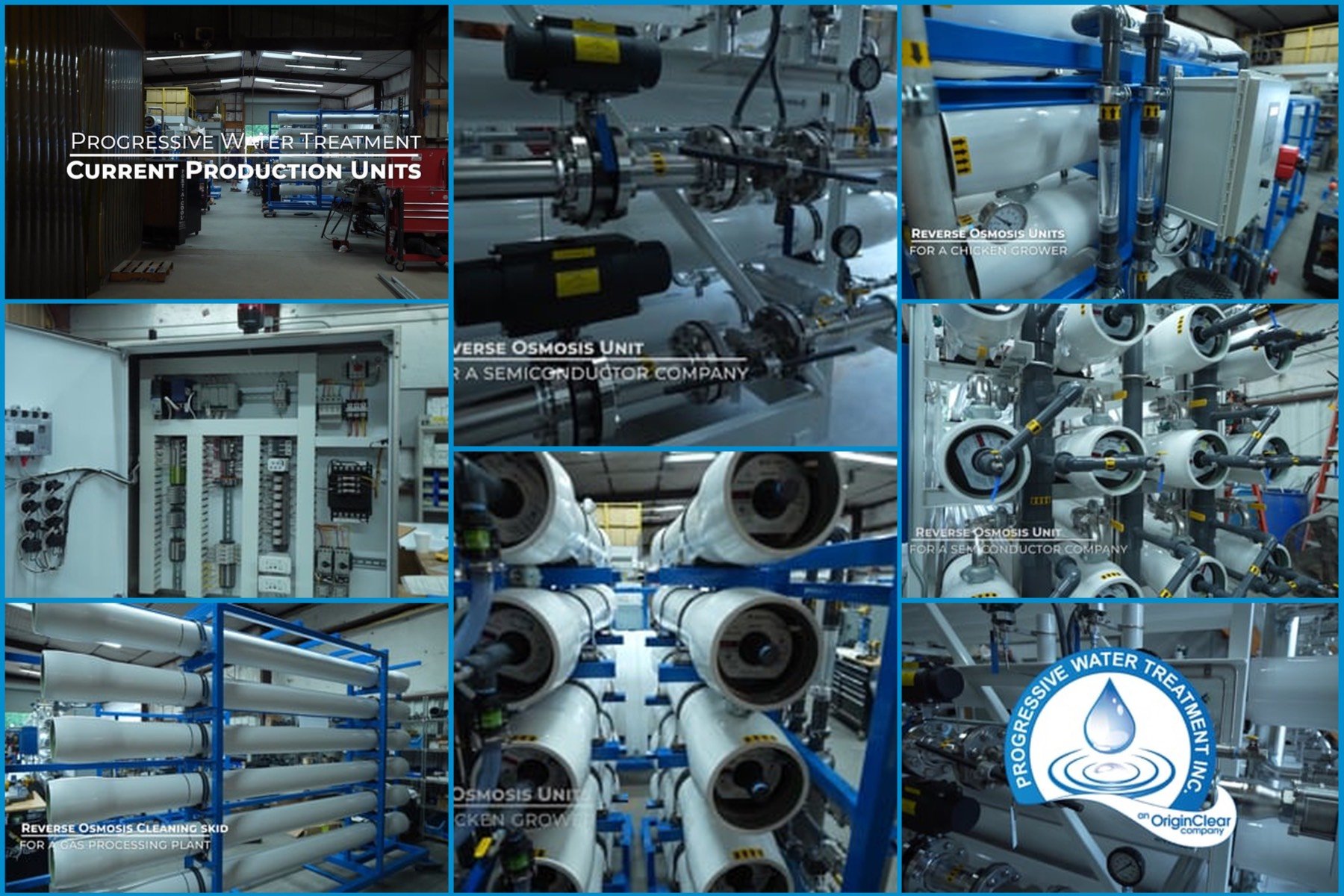
Quality Workmanship
That is beautiful. Just notice the... I love the quality of the work, the workmanship, the welds the product, this team is just amazing.
Before I go on, I have a little chat with Garcia, who's... works with us on our crypto side, says this is very innovative and he is so right, this biofilm thing. We will be, we will be covering it in the future, so standby for that. All right. So, now we're going to go into tech slides, which is why I slipped out of the share. So I could recalibrate without the fuzzy video mode.
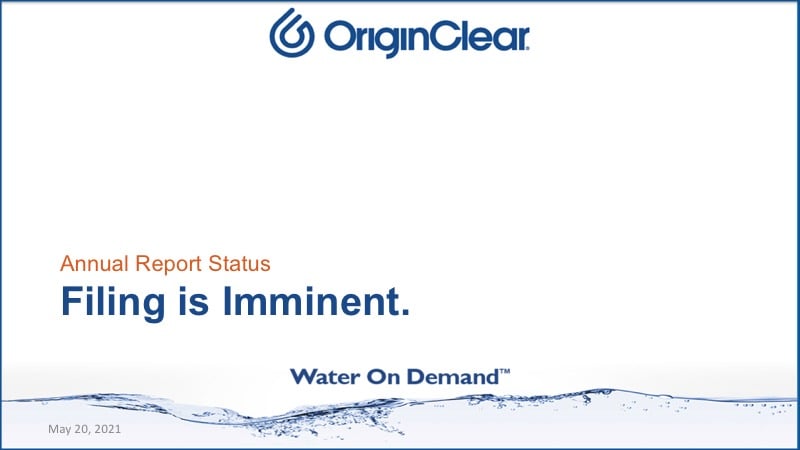
Annual Report
Okay. Here we go. All right. What's up with our annual report? God, this is like the return of the zombies. All I can tell you is filing is imminent. Believe me, it is imminent. I cannot say it is super imminent. As to the fix, well I have some very good news there because we intend. And you know that when I finally deal with something, I finally deal with it.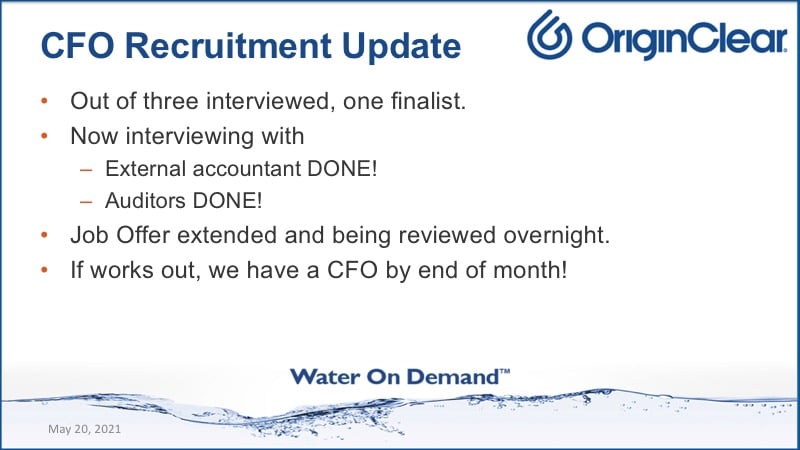
CFO Update
Is that we have the interviews of our CFO candidate with both the external accountant is done. And we got a full report yesterday from Gwen and then the auditors who are independent, they didn't actually interview, they just had a conversation because they have nothing to do. They're independent, they have nothing to do with the job process, but they felt that he seemed familiar. So they were not passing judgment, it's not their job.
So we have extended a job offer, and he's reviewing it overnight. So, I fully expect to have the CFO within a matter of days. Now, remember that our quarterly filing is due on the 14th of June for the first quarter. So very soon. With a five day extension allowed by law. So, up to the 19th.
So, we're not planning to put a CFO in place before that's done, because we don't want to rock the boat. Now what's going to happen is this person, he's a male, he will be working from the ground up, putting in place the proper processes that we need, because really what we lack; we have a problem with basics.
We do a lot of wonderful stuff, but this is really basic stuff. And interestingly enough, none of the problems with the annual filing had to do with Progressive Water, with all the tracking of job costs and labor, that's actually doing really well.
So, what the problem was, I can tell you, this is that it was all about... Is it amazing amounts of of equity issuances we were doing and complexities of that, and it got into pages and pages. In the next briefing I will show you this stuff and you'll see what exactly happened.
New Trademark
Okay. So moving on to exciting news, we filed a trademark and it's called $H2O. And I'll show you the filing right here. And there it is. So, this is what we filed on Sunday. And so what we filed was a patent. You can see what the identification is; managing and verifying cryptocurrency transactions on a blockchain, et cetera.
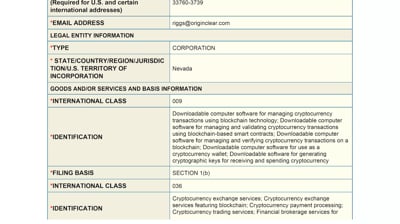
Intent to Use
Section one, B, which means intent and intend to use. We can't just put the name on our website and say, we're using it. You actually have to be using it as a coin or a token or whatever, but intent to use reserves it for you. So that's the one B. All right.
Cryptocurrency trading, cryptocurrency transactions, cryptocurrency payments in water related projects. All right. And then I think that's pretty much it, the rest of it is just general stuff. But what this means is that we have the $H2O coin. Now there was an $H2O coin back in 2015, it failed. And in crypto when a coin fails it really does, because you can look up the H2O coin, it just went away.
Then you can take over that name. So H2O is the name we... Because H2O as a name is taken as a trademark, we were able to trademark $H2O. And so that.... Which is very common for crypto names. As to the platform it's on, remember this is still in development, are we going to do non fungible tokens? Remember fungible means you can swap it back and forth. A non-fungible token means you cannot swap it. It is unique. We're about to cover this in our new report. So, let's go back to the presentation.
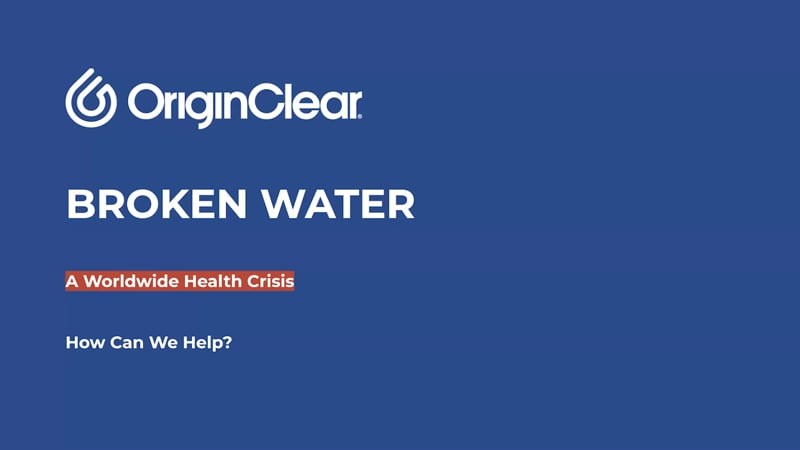
Presentation
You're going to be the first ever to see this actual presentation. So I'm going to flip over to Google slides and start. All right, well, this is Riggs Eckelberry and I'm presenting to you Broken Water, A Worldwide Health Crisis. How Can We Help? Let's take a look.
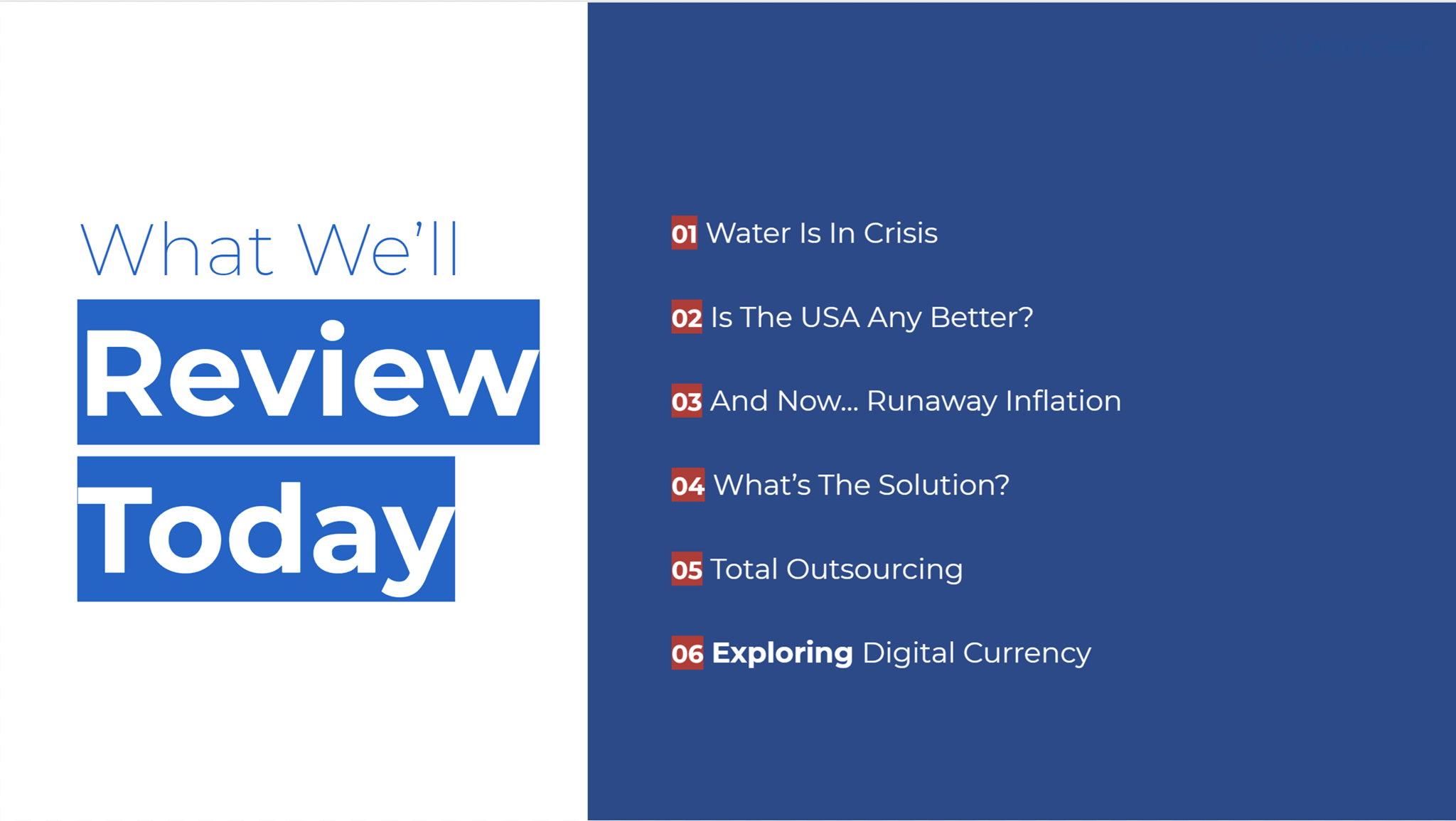
So we'll be reviewing how the waters is in crisis is the US any better? What about runaway inflation? What's the solution? How outsource can help. And finally, how we're exploring digital currency.
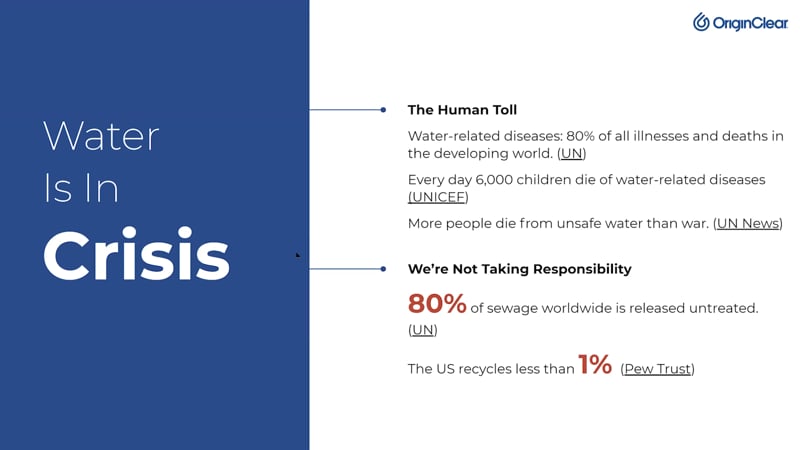
The Numbers
Of course, you know some of the numbers, 80% of all illnesses and deaths in the developing world come from water. 6,000 children per day die. More people die from unsafe water than war. And 80% of sewage worldwide is released untreated. And we, even though we actually treat it, we flip the number, treat more than 80% of our sewage, but we only recycle less than 1%. So, we're not exactly responsible players. You kind of knew that didn't you? All right.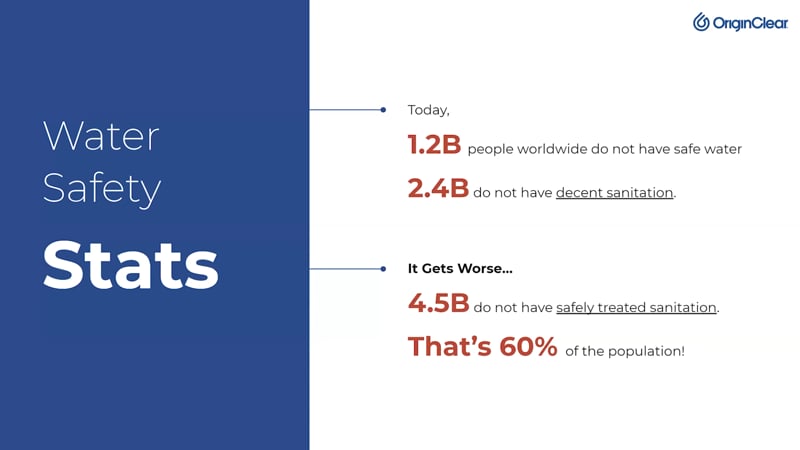
Water Safety
Water safety; 1.2 billion to not have safe water now, 2.4 billion don't have decent sanitation, which means things like a ventilated latrine pit. I mean, pretty safely. Pretty basic, right? All the way up to flushing toilets. Now here's... 60% of the world's population do not have safely treated sanitation. What does that mean? That means that the... What comes out of the toilets doesn't get properly transmitted to a sewage plant or whatever. It just goes into the groundwater and so forth. So that's a bad problem, of course.
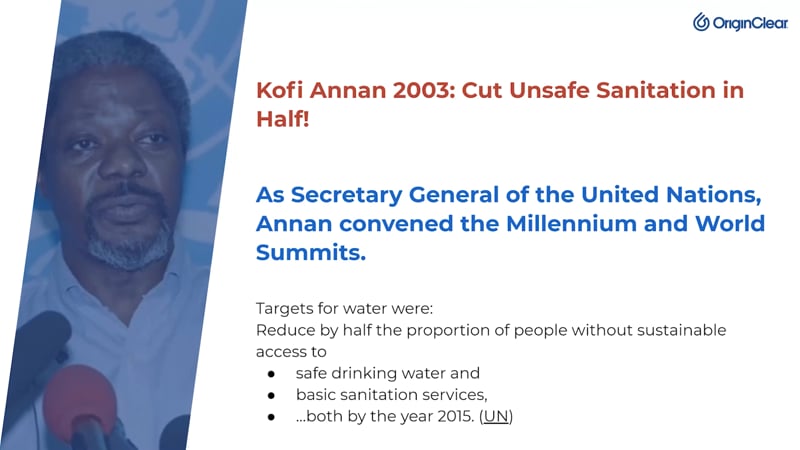
Kofi Annan, back in 2003, he was secretary general of the United Nations and he convened summits that basically said, "look, we're going to reduce by half the proportion of people without sustainable access to these two things by 2015."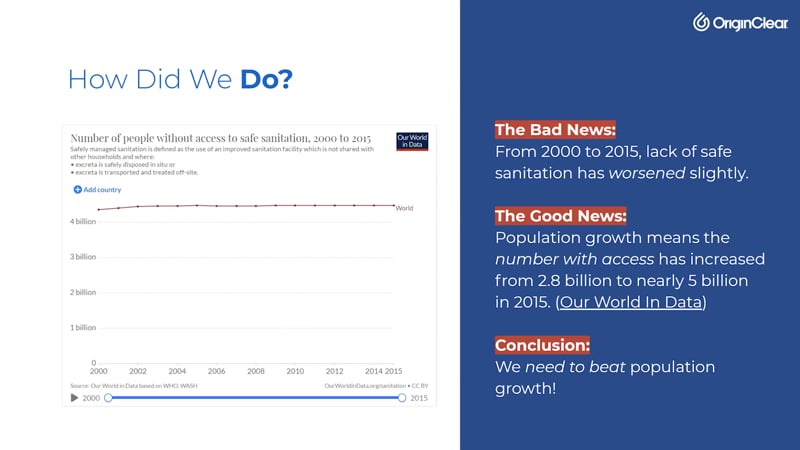
So let's see how we did. Well, we actually have fewer people... The number of people without access to safe sanitation has risen. Now, on the other hand, we've had a population growth of nearly double and the number with access has increased to nearly double what it was. So, we covered the population growth, but we didn't beat it. The same basic number stayed in place. This 4.6 billion number is kind of locked. And that's the number we've got to beat.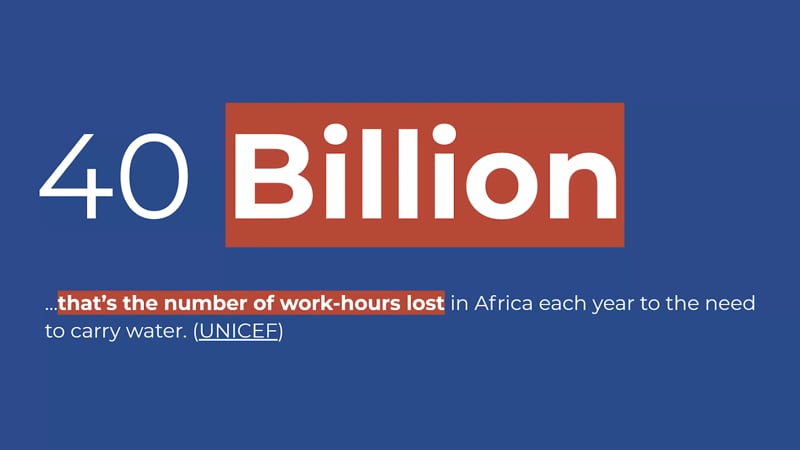
All right. So, here's another amazing fact; 40 billion work hours lost in Africa each year to the need to carry water. That's roughly a billion hours a week in Africa. It's crazy.
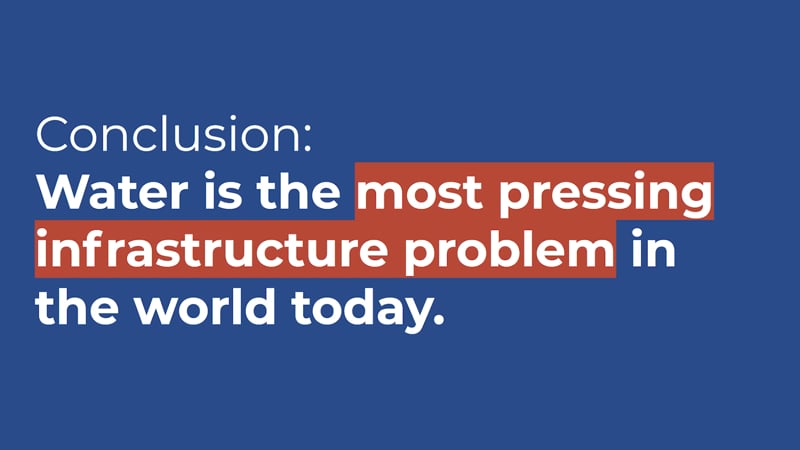
Water is the most pressing infrastructure problem in the world today. We think of roads and bridges and so forth. Even putting an internet and so forth. Frankly, water is the most important. And I would argue it's the most neglected in relative terms.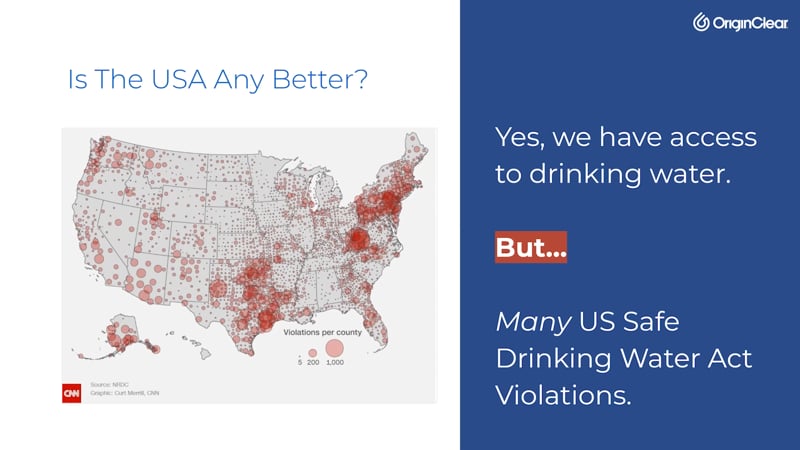
Now, we say "we're good." Well, we do have access to drinking water. I like to say that you won't die right away from the drinking water, but thousands... Tens of thousands of US safe drinking water act violations in any year.
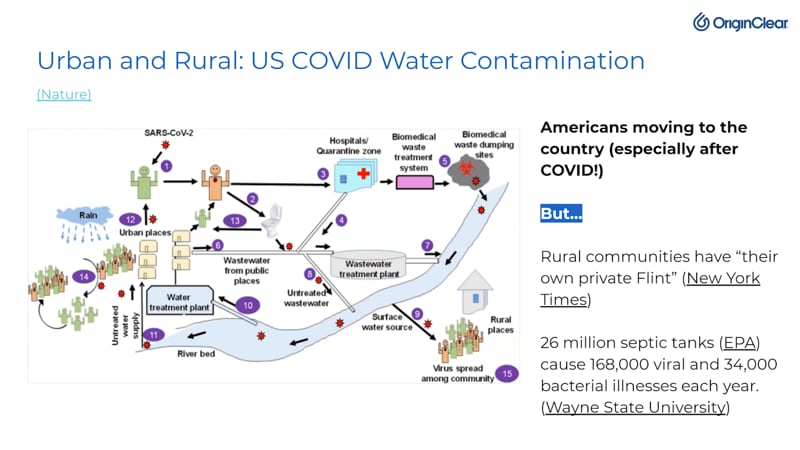 Viral and Bacterial Illness
Viral and Bacterial Illness
Now this is an interesting topic. People are moving to the communities, the rural communities, and oddly enough, the rural places have more problems because their water systems are not as great. So you're going to see a problem with people moving from the cities, out to the country and overloading those systems. Now, 26 million septic tanks have been built for all the people moving out to the countries. A broker living in Bozeman, Montana is now going to have his... Bozeman, Wyoming I believe it is. No, no, it's Montana. Bozeman, Montana.
He or she was going to put in a septic tank because they're nowhere near the sewage plant. Well, they cause a grand total of a couple of 100 thousand viral and bacterial illnesses. So, this is especially sensitive because of the... We really started to pay attention to things like COVID and some say, that's not the end of it, so we have to pay attention to this.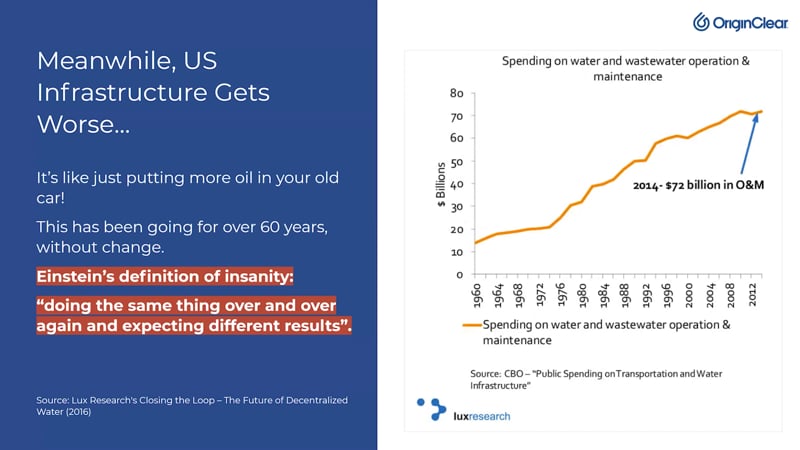
Infrastructure Worsening
Okay. Now, in the middle of all this US infrastructure has been getting worse, steadily since 1960. We've been spending more and more on operation maintenance every year. Like putting more oil in your old car, Einstein's definition of insanity.
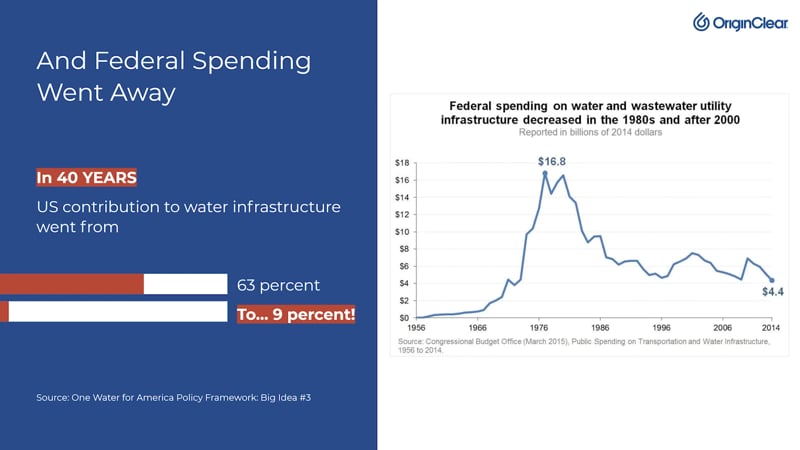
And you don't know this, but a federal spending, which was not that great to start with only $16 billion a year, now went to 14 billion in 2014 and it's gotten worse. So it's now below 10%. 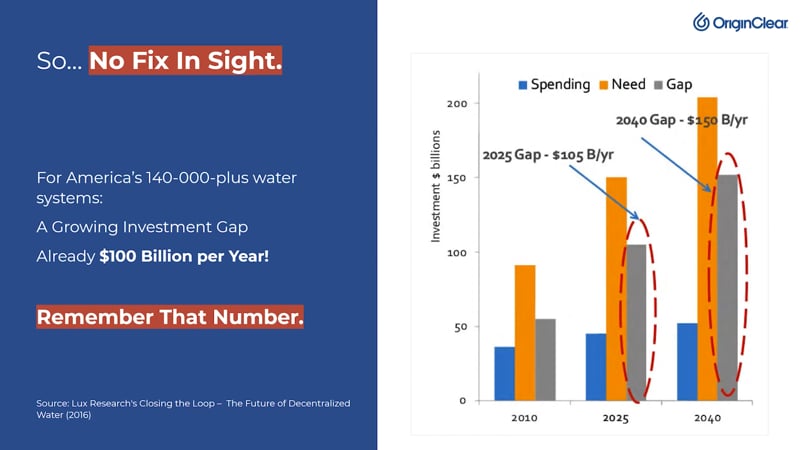
No Fix in Sight
Of course, the problem is that there's no fix in sight because of this 100 billion... It's actually a hundred billion dollar per year investment gap in our 140 thousand plus water systems. Now, remember that number.
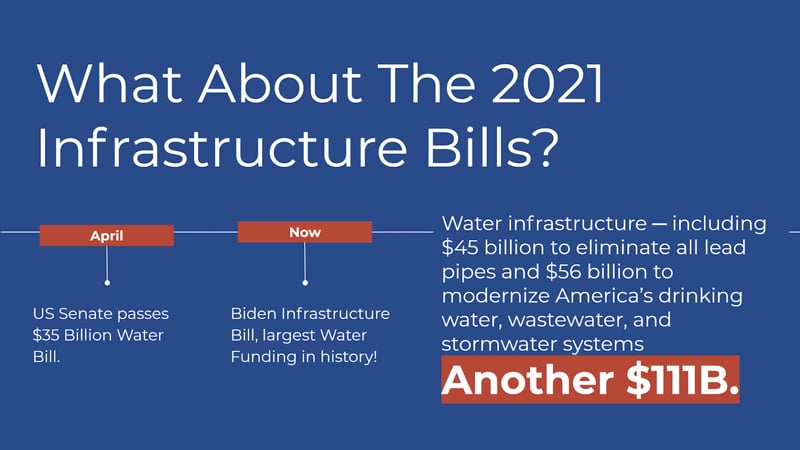
As you know, the US Senate passed the $35 billion water bill almost unanimously. I think there were like two people in the Senate. So bipartisan people want to fix it. And then the large infrastructure bill coming along, the $2 trillion one is another $111 billion.
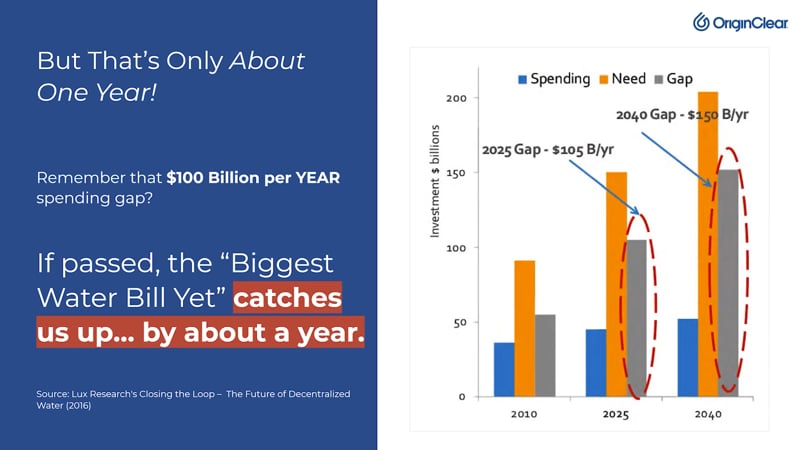
Well, what does that do for us? That's only about one year of catch-up. So what does it do?
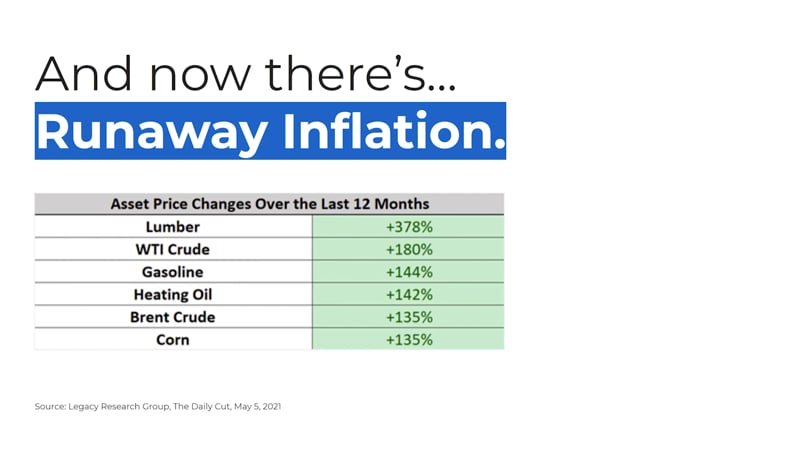
Triple Inflation?
Now, here's what's even worse about it; runaway inflation, as you know, lumber and many things, including corn, have more than doubled and in the case of lumber, almost quadrupled.
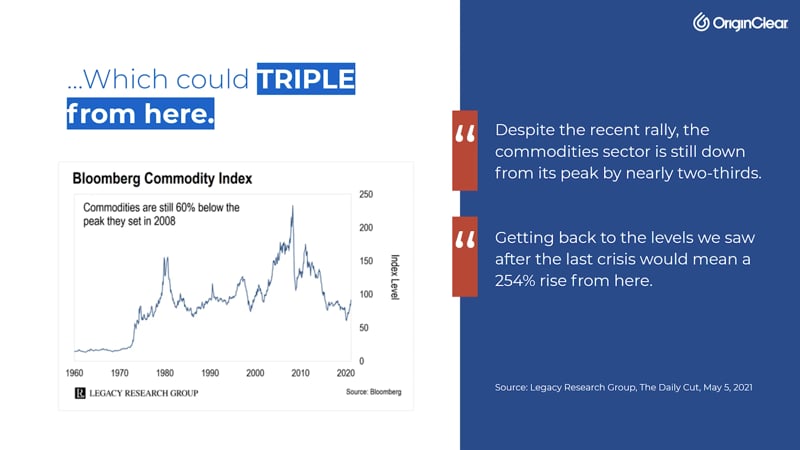
And what does that mean for the future? They could triple from here based on what happened in the 2008 recession. So think about it. It number could go to 12 times its cost 12 months ago. That's a very, very difficult thing to think about.
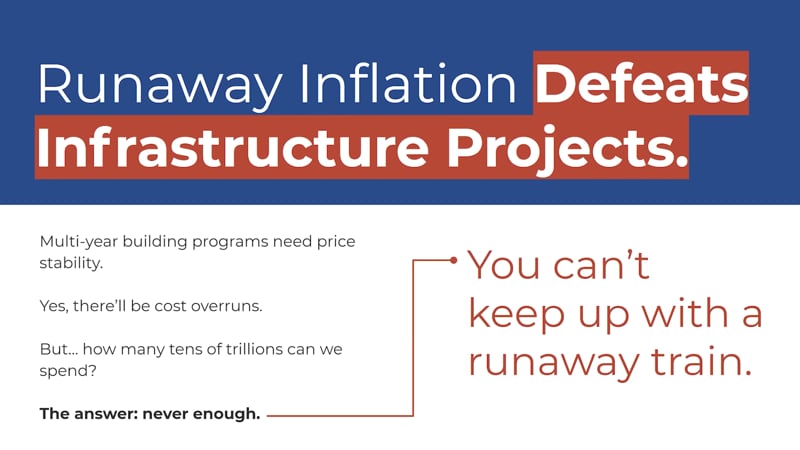
Can't Spend Enough
Now, runaway inflation, defeats infrastructure projects. Argentina has 50% per year inflation. I guarantee you, they're not doing major infrastructure projects because you need price stability. You can keep adding on more money to it, but you just, you can never spend enough and you can't keep up with a runaway train.
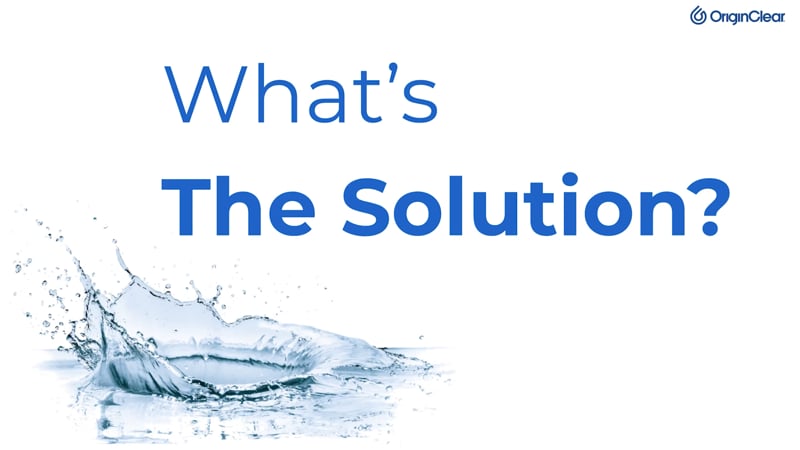
'So what's the solution? What do we do about it? And that's where you and I, my friends, we can do something about this.
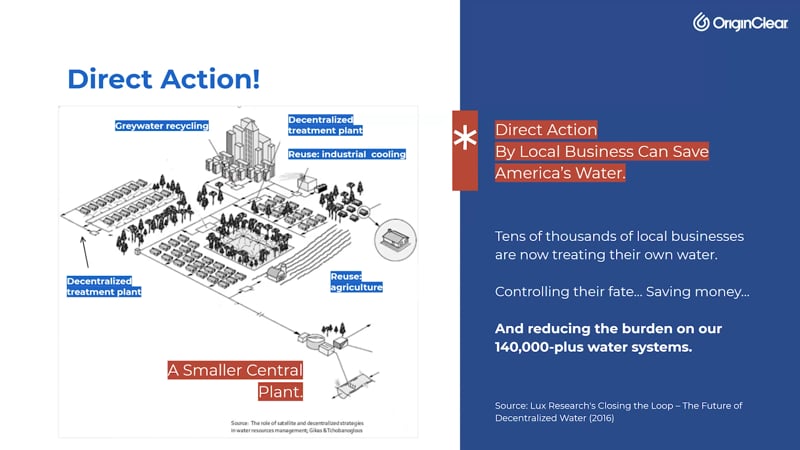
Decentralization
Direct action. Direct action by local business can save America's water. As you can see in this diagram, we have a number of different decentralized plants, a commercial building, a animal farm, agriculture, industrial cooling, et cetera, all enables a smaller central plant. So you're taking the load off the central system.
It's decentralization, just how we took the load off of all... Back in the day in the 50s, we had mainframes and a big load and everybody's waiting in line. And then we pushed all the processing out to personal computers, and now the central computers are not so overloaded. And it works very well in high tech. This can be done in water.
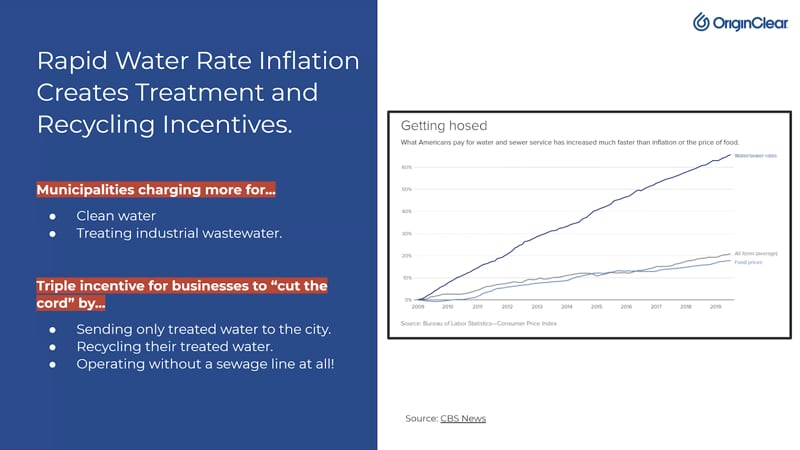
Actually Happening
And it is actually happening. Why? Because there is a financial incentive. We're seeing it again and again, and again. Businesses looking at municipalities... For example, there's a brewery, a Russian River Brewery in Sonoma County. They saw the Sonoma County rates for treating their wastewater were going out of sight and it literally made sense to go ahead and install a system. So financially they were well ahead doing it themselves.
Now they can cut the cord by sending only treated water to the city, which means they don't have to pay. Recycle the treated water, get more than one use out of it. And they can cut the cord and not operate a sewage line at all.
Direct Business Action
And that's what we did for example on the right-hand side, a dealership in Pennsylvania that was able to relocate without connecting to a sewer line. Many other categories of businesses that have either installed or working with on bids actively right now. So we know this direct action is happening. Why? Because we're there and we are the player who's doing it.
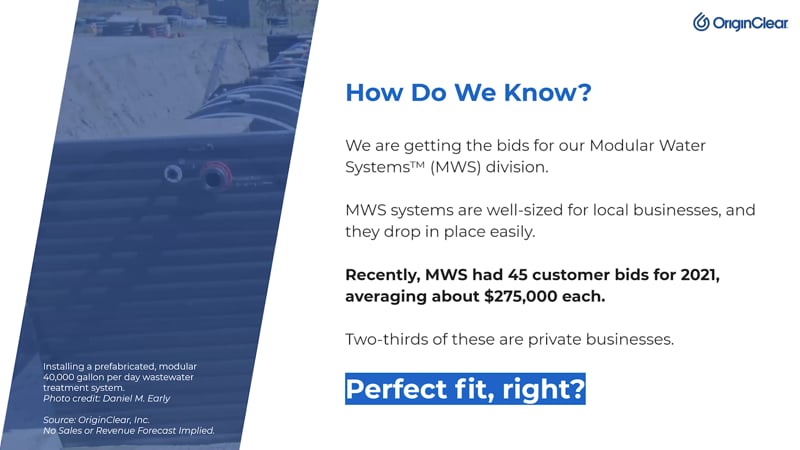
How do we know? Because we're getting these bids. Modular Water Systems™, is a picture here on the left of one of our $40,000 a gallon per day systems that was built by Dan Early in a previous life. And we have these bids. You can do the math on how much that is. Well, two thirds of these are private businesses. Therefore they qualify for this.
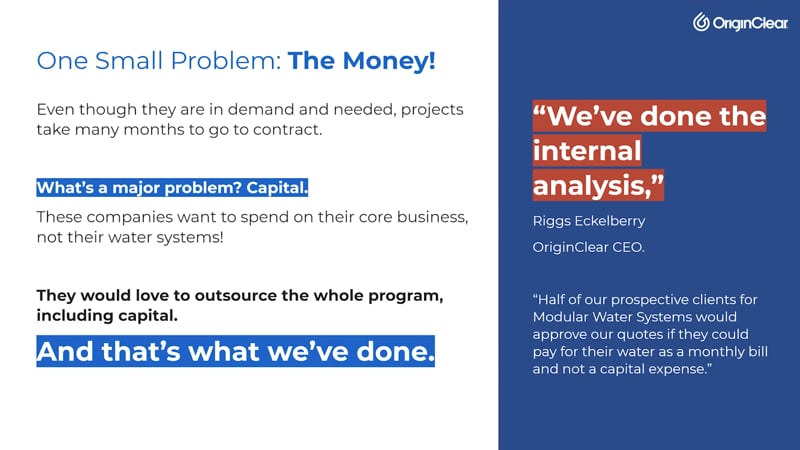
Finance a Barrier
Perfect fit? Yes, but what's going on? Money. These things take months and months. I watch the forecast. We have a meeting every Monday morning, I looked at the forecast and things move like a snail and Ken Berenger and I who were strategizing over this for the last year.
We're like, "How do we break this? How do we break this?" And we realized, "It's the funding stupid." Half of our prospective clients for Modular Water Systems would approve our quotes if they could pay for their water as a monthly bill and not a capital expense. And that's what we're working on.
Accelerating Water Treatment
So we launched Water on Demand, which is a financial play to accelerate water treatments so money for money. And it means that as we raise capital for this, we don't have to have Progressive Water do all the work. And if it gets overloaded, we can give the business to other water companies.
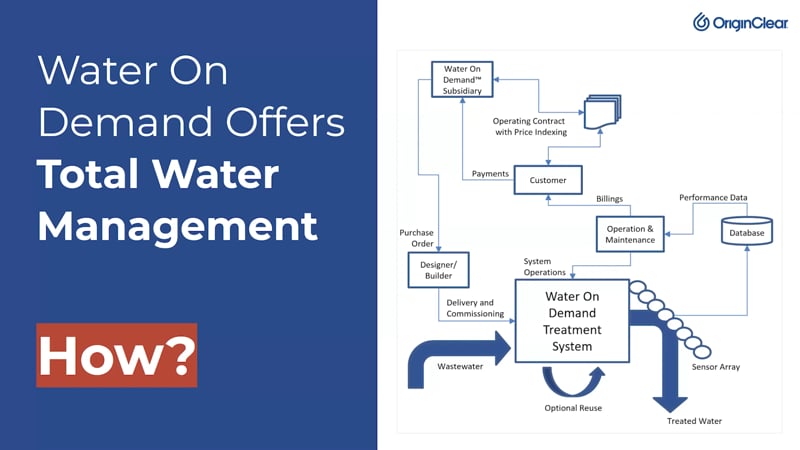
But for the client it's total outsourcing. What does that look like? Well, you saw this diagram last week.
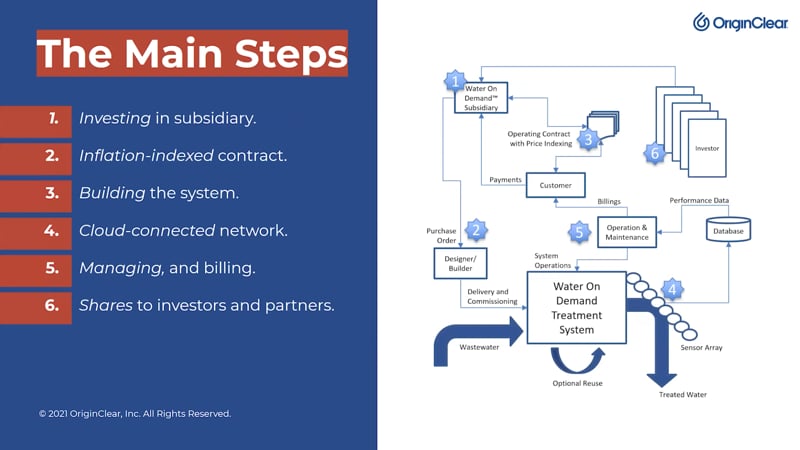
Breaking it Down
Let's break it down. Number one, there's investment in the subsidiary that we put together called Water on Demand. Number two, down there on the bottom left, there is building the system. Actually these things are flipped around. They should be... So number two is operating contract with price index. And then at the bottom left is the building. Number four is the cloud connected network, bottom right with the sensor array. Five managing and billing it. And six shares of profits to investors and partners. So that's just doing it the classic way.
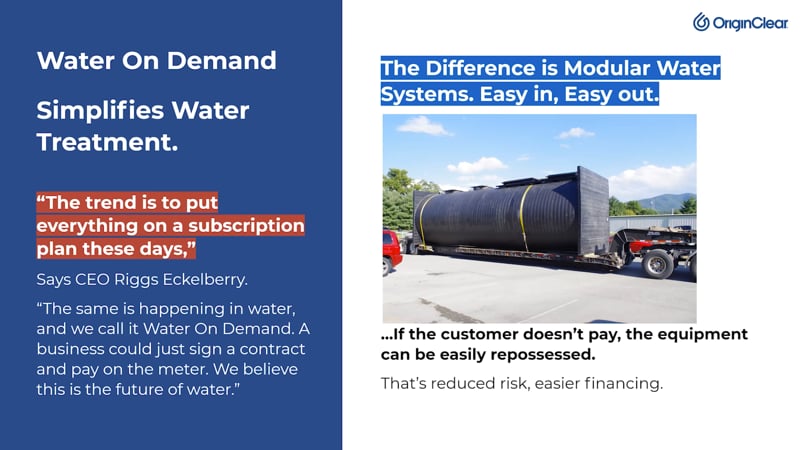
Rent-A-Center Model
Next thing is really... What's great is combining it with our Modular Water Systems™. Which are roll in, rollout. If the customer doesn't pay the equipment as repossessed, therefore we don't have to take an arm and a leg from them. We don't have to get personal guarantees or anything, because we can take it back. It's the Rent-A-Center model, as I say.
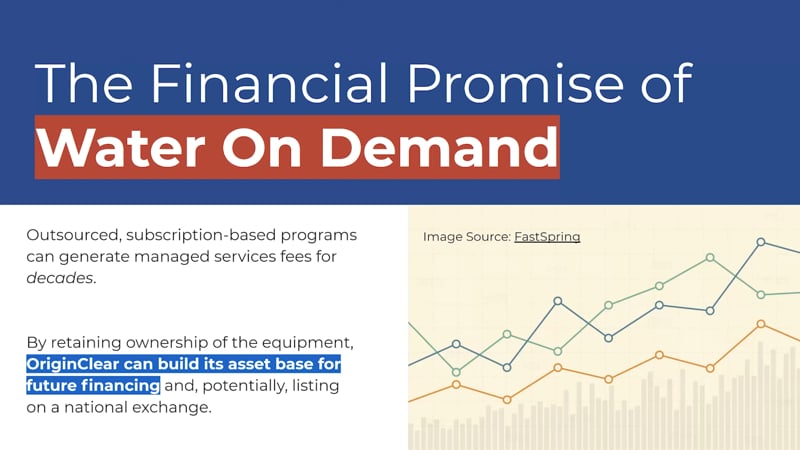
Outsourced Subscription Water
So what does this mean? It means that outsourced subscription-based programs can generate managed services fees for decades, not what Progressive Water does. All those machines you saw on that video, they're sending them out, getting money and going... Maybe they keep a service contract, but they don't have the full outsourced managed services.
Now we're retaining ownership of these machines. We're not selling them. When we finance Water on Demand, we keep the equipment and we just charged for use. This builds our asset base and potentially is what we get to use for the potential listing on a national exchange. So that is one of the big things that I work on as an ambition, is to get onto the Nasdaq.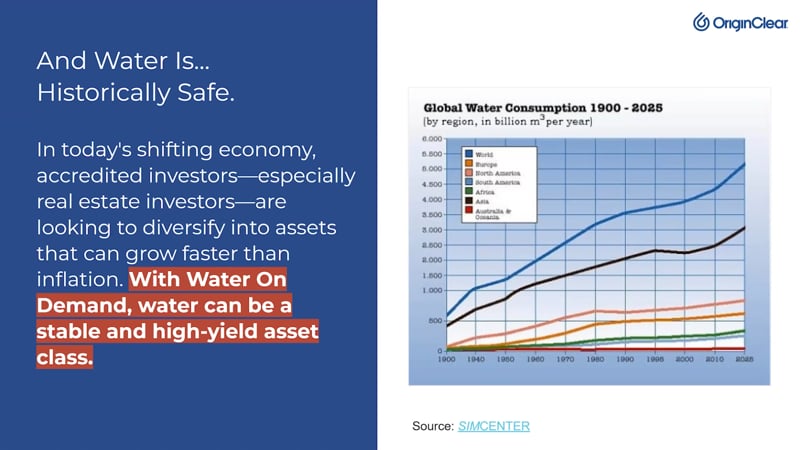
Demand Keeps Increasing
Now for investors, water is historically safe. Is stable and high yield. Look at global water consumption, it just never stops. Right? In fact, some of the biggest growth is in Asia, as you can tell. That's really taken off. So the whole world there, is just keeps on rolling. Water is never going to be in less demand than it is and of course we know it gets worse.
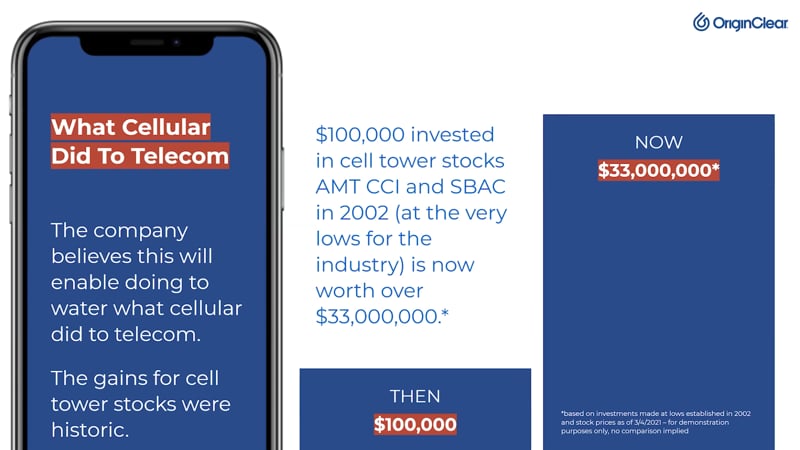
Like Cellular to Telecom
We like to think it's a lot like what cellular did to telecom. Remember that places like Africa had no telephone systems. And so cell tower companies like AMT, CCI and SBAC went and put in these huge networks of cell towers. And of course they that had huge gains.
The point is this, we basically have no infrastructure for water. We have bad infrastructure in America, and we have missing infrastructure in Bangladesh, Africa, you name it. They just dump it in the rivers, the ground, et cetera. So really what it is, it's just putting in a new mobile network.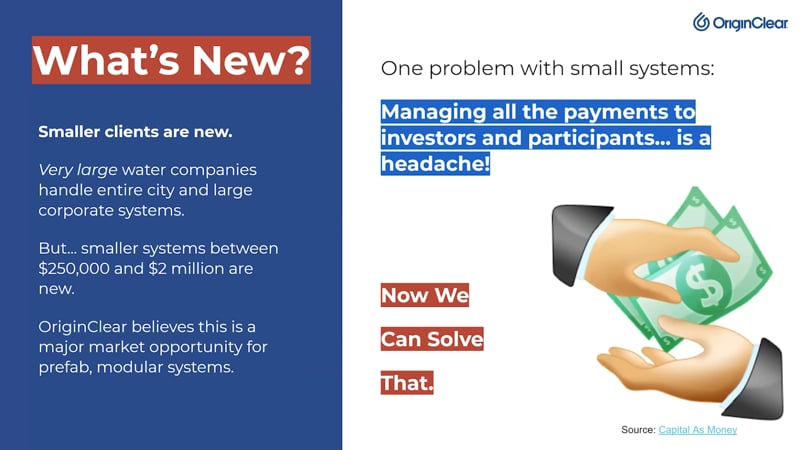
Scaling Down
Now what's new? Because Water as a Service® as it's called, have been doing... When you have happening with these large systems, for example, AquaVentures was doing, still is doing, island systems that they do on the meter, but they're huge desalination systems.
But the smaller ones are new. And the big water companies don't know how to handle it yet. And also they don't have the Modular Systems like we do. The patented Modular Systems and that's where we come in.
So now here's the problem with small systems, manage them is a headache. And we know this because we pay dividends currently on our unaccredited round that we did up until the 27th of April. We paid dividends as low as $4.18 cents per month. This is ridiculous, right? There's more time in handling these things. So we looked at what the solution was, digital currency.
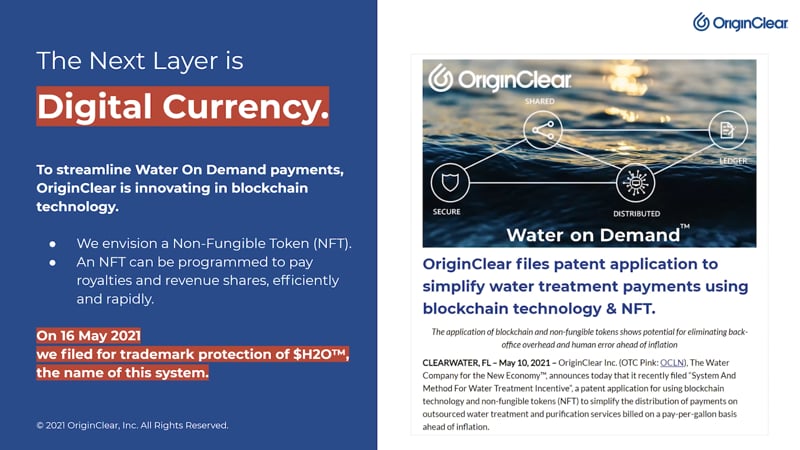
About NFTs
Now we envisioned something called a non-fungible token. I told you that fungible means that you can... $2 bills are fungible. You can swap them. Non-fungible means no, this dollar bill, whatever it is, it cannot be substituted for that other one. For whatever reason.
So it's being used right now, for example, for art. To lock down on people selling houses with it, right? One house does not swap another house. They'll different land, have different deed, different owners, different everything.
So an NFT is a way to identify a specific revenue, in this case a revenue stream. And as you know, we filed for trademark protection of this. What we're calling H2O, $H2O.
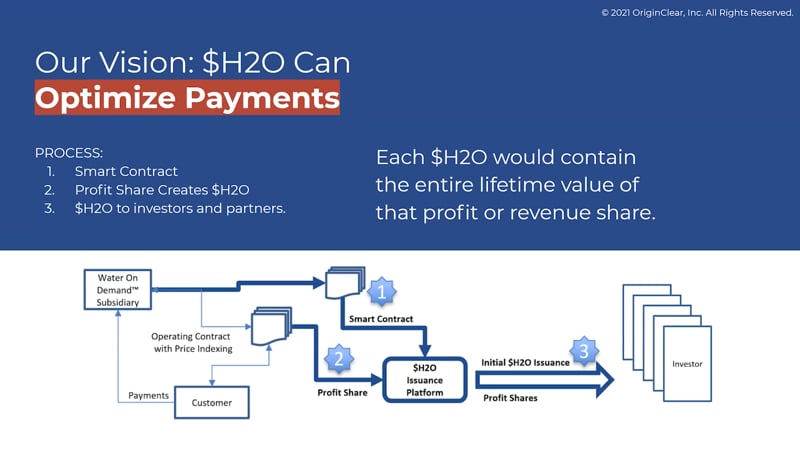
Now $H2O can optimize payments. As you can see here. Number one is a smart contract. Number two, it leads to a profit share, which then the profit share is turned into this coin. And each $H2O contains the entire lifetime value estimated of that profit or revenue share.
So let's say there's 25 years of operation for that machine. It generates X amount of revenue plus inflation. And that is built into that little silver called H2O that is issued.
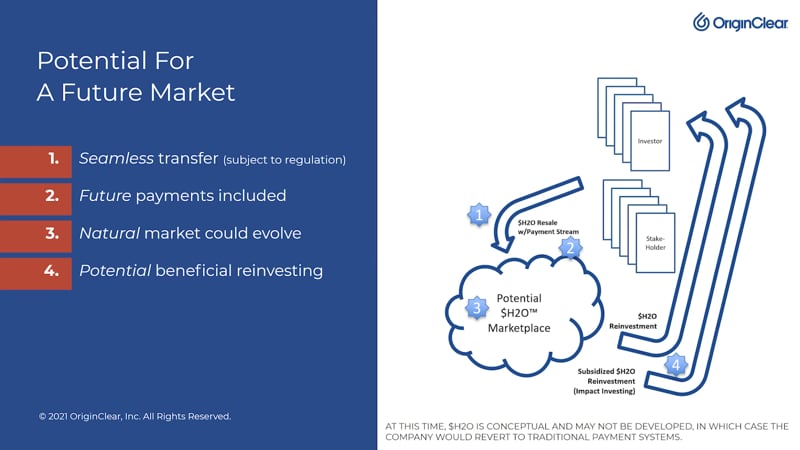
Future Market Potential
Now what's the logical thing that happens next? Potential for future market. Now the transfer is seamless. Why? Because it's in a crypto wallets, just have an address. You can transfer it. And now OriginClear doesn't have to worry about where does the payment go? It goes to the wallet always. So it takes that problem away. And now these things become swappable and the future payments are included.
We think that just as what's been happening in NFTs in the world, natural marketplaces... I think they did $2 billion in transactions in the first quarter of things like baseball cards and so forth. Yeah, you say, "Well, baseball cards." But that's a test and it shows that natural markets can grow. Nobody's overseeing this NFT market for baseball cards. It's just a platform and people go for it.
Now here's what's really interesting, is that Water on Demand Inc, though subsidiary, could accept these back for investment. And so there would be literally a loop back to create even more benefit and opportunity to be subsidized re
So this is an exciting, exciting vision. Now it is conceptual and it's possible that this would not be developed. We had our big experiment in 2018, we hit crypto winter and we had to bow out. But we're back and what we... Really 2018, we learned so much, which is keep it simple. And we believe this is. But if it doesn't work, we'll just simply pay things through the deluxe electronic check market or whatever or PayPal. There's ways to do it.
Global Marketplace for Water
So this does not interfere with Water on Demand, but it's vital. And I believe it will lead to a global world marketplace for water, the first ever. There are no marketplace for water because water is considered local. Well, the minute you extract from water, the payment stream, now it's a money instrument and it's represented in this secure... Because what's cryptocurrency? What crypto means cryptography. It means security. It means you can't... If you lose that thing, there you are. You can see it on the blockchain, but you can't get it if you don't have the address, the private address. And so it's secure. And that means that now you have made water global as a market and that's amazingly exciting.
Stay Connected
All right. Well, we're building daily and very important for you to stay connected. Here are our friends from Philanthroinvestors. They've been wonderful supporters. They're really helping us bring, as I say, so much of the international market.
Top left is Alfredo Guatto. Bottom left is Ivan and Bella Anz' who are just amazing supporters. Bottom right Omar Paoloni, he is just a fantastic guy. So I love these guys and girl, and we like to think we're America's most transparent public company. We'll tell you everything that we can say within regulation. And remember you get replays. So if you miss this you can always go, just make sure that you're subscribed.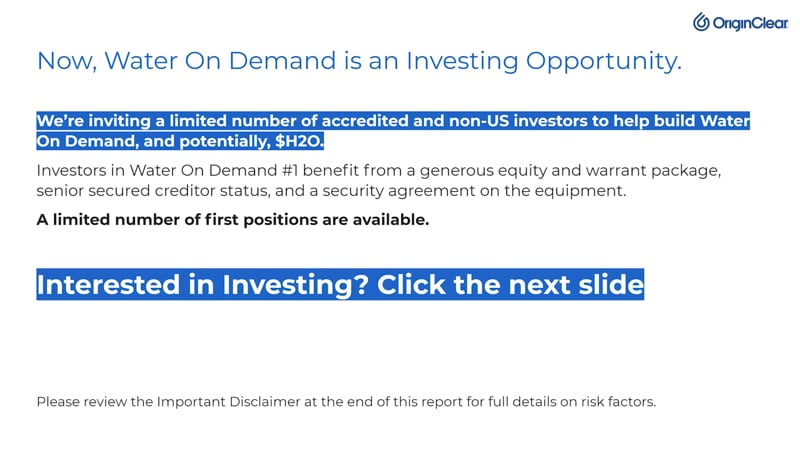
Investing
Now is possible to invest in Water on Demand. I'm not going to get into the specifics. That's a bit later in the show. But to invest... There's Ken and of course like everybody who's been in COVID, he doesn't really wear a tie every day, but he does dress up. He dresses up good.
And Ken has been just literally...He and I share a brain. He knows exactly what's going on and you can get a great idea and he has the time to speak to you. But his calendar is very full, so don't hesitate to click on it, but please be accredited or investing from outside the U.S. Thank you.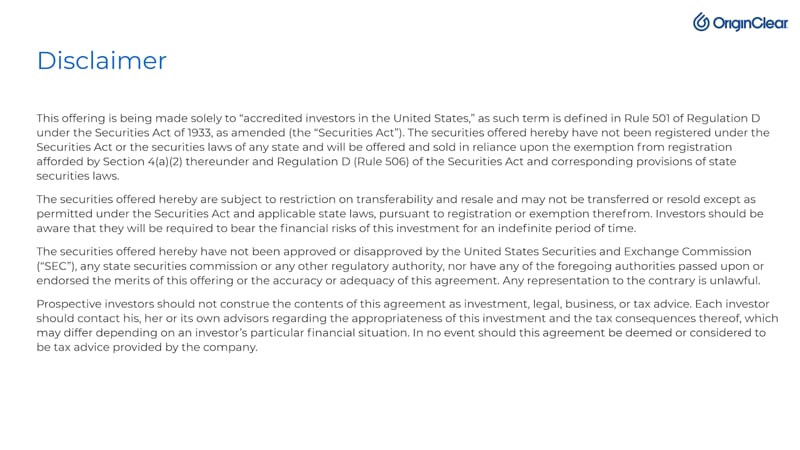
Disclaimer
So that is the, obviously we have a disclaimer, which is the offering I was telling you about is under Regulation D for credit investors and the safe harbor statement, which you've already seen. So that takes us back to the presentation. And I hope you enjoyed it. Obviously I have to fix a couple things like that little flow chart, but it's a premiere and we will be spreading this far and wide.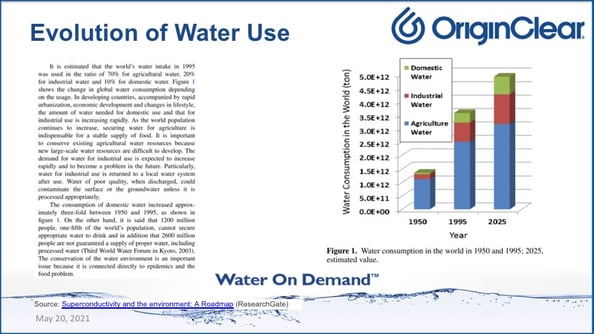
About Water Use
All right. I thought I'd share a couple of additional facts about water use and inflation. Interesting thing from an article on ResearchGate gate called "Superconductivity and the Environment." And it talks about a particular technology, but what's interesting here is to look at the trend and we really see that while agriculture is still the largest amount of usage, we see growing use by populations and industry. Now, agriculture is working hard to become more efficient and, and they really want to make sure also that when the home use and industrial use is badly discharged it doesn't go into agriculture.
So this is why, you know, we have this problem with 60% of the population having that, you know, unsafe sanitation that goes in the groundwater and literally it's in your broccoli. So that's, this is 5 trillion I don't know actually. It doesn't say I looked in the paper, but nonetheless, it is a fascinating chart in terms of relative amounts.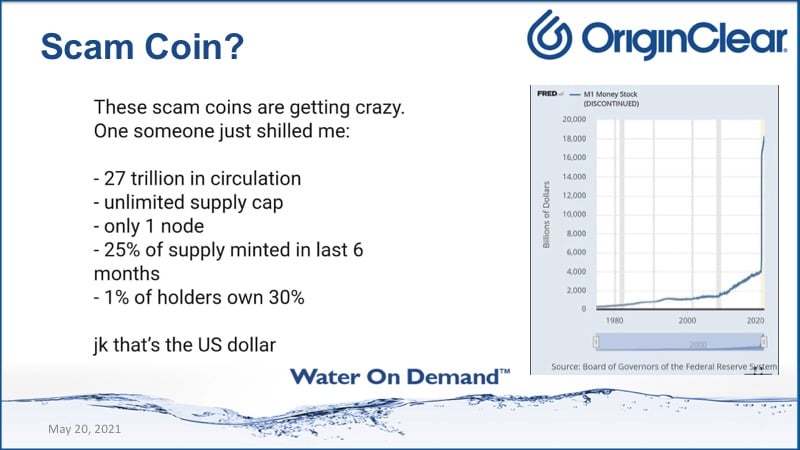
Inflation
All right, now the next thing. I saw this about a scam coin. 27 trillion in circulation, blah, blah, I, this is a coin you would never invest in guess what? That's the U.S. Dollar and on the right, you see the money that used to be called the M1 measure of money in circulation, that has been discontinued. It went sky high and they just gave up.
They just gave up when they got to trillion, 20 trillion over 18 trillion is okay, whatever. So that is not a great sign. And it means that, you know, there's a lot of money moving into safe places, and now water is becoming one of those. And it is inflation plating, as you saw in the presentation, far higher than normal inflation. So remember that because it's not good news, but maybe we can help.
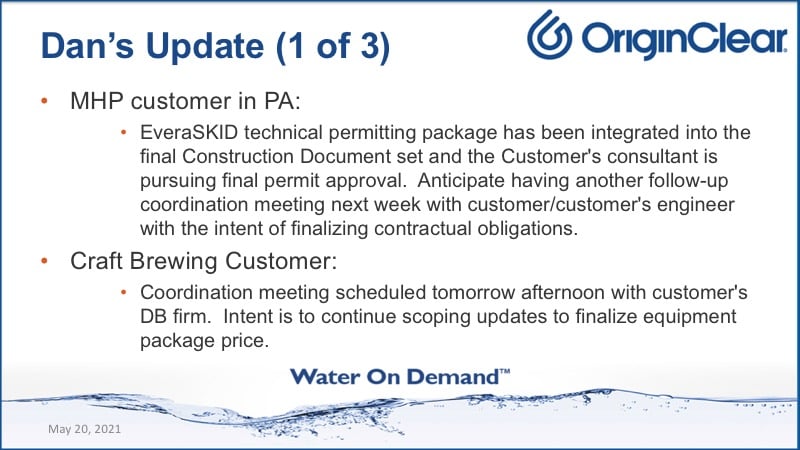
Report on Outsourced Projects
All right. Now these outsource projects, the report from Dan quickly, I'm going to cover this. The MHP, that means trailer park, mobile home park, customer MPA that's continuing those follow-up meetings.This is the usual end of stuff, but it's moving along. Craft brewing customer is also going well.
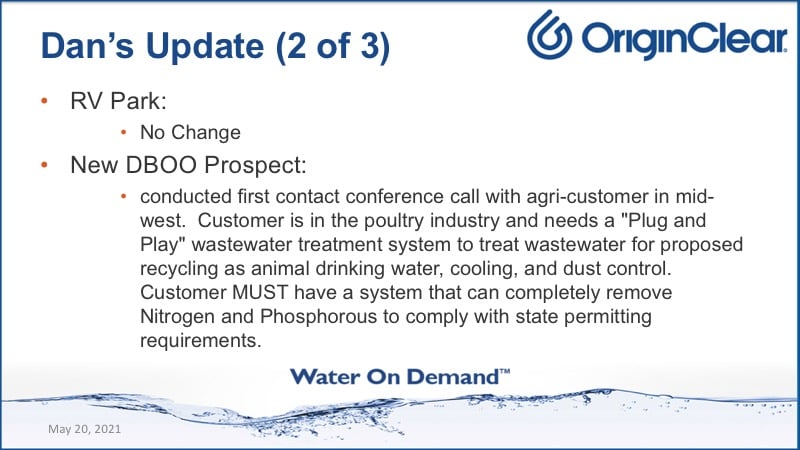
Then we have a new design, build, own, operate that that's basically the word water industry uses for outsourcing. And this is, this is an animal farm in the Midwest, in a poultry farm and they needed a plug and play, and they must have a system that will do all this. And they are wide open. They love the idea of something fully outsourced, including the capital. So no lack. When you say, you know, you don't have to pay up front guess what a lot of people get interested.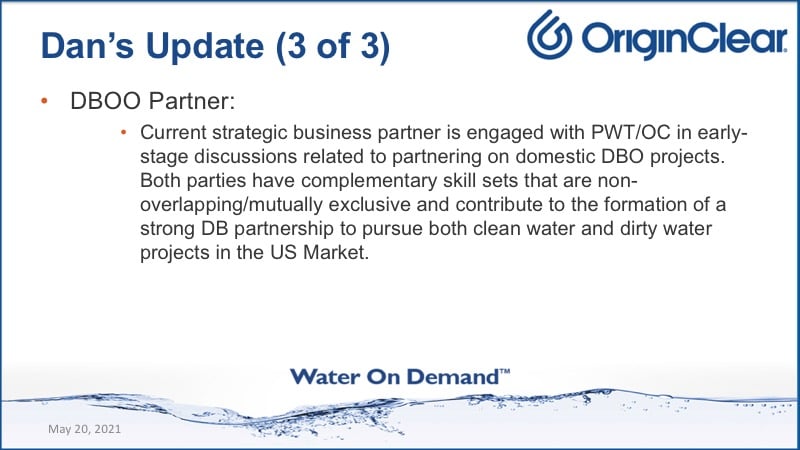
Managed Services
And finally, this is really cool. Tom and Dan have connected with an amazing partner, a potential partner, that is a well well-developed ability to run these design build and operate projects. So they have the technology and they need us to do design and build. So this is a really, this could become really, really exciting.
And, you know, I'm very concerned that as we raise the capital, we throw the money at a water at our water company. Well, they better know how to do the managed services and deliver the good water by the gallon so that the fund gets paid, right. Otherwise the whole thing breaks. So I'm really, really, you're going to hear much more about this. This is probably the most important thing I've discussed tonight.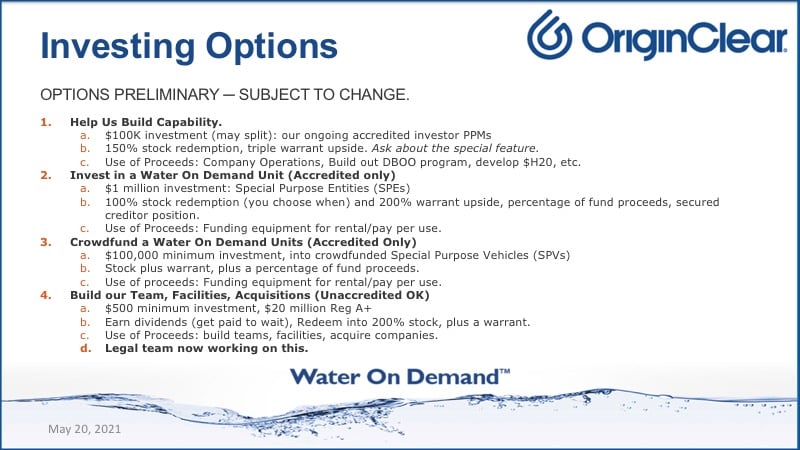
Investing Options
Okay. Quickly. Now the status here, the hundred thousand investment, which you can split up. There's a special feature that will blow your mind. If you're interested in investing, you can invest a small amount, but you must be accredited.
About NGOs and Donations
All right, let me stop quickly for a chat here and very innovative, Tony B, have you approached Matt Damon? He cares very much about fresh drinking water for underdeveloped nations. Yes, Tony, let me say something about NGOs.
We're going to fix NGOs. My experience with non-governmental organizations, charities, is you are instantly the deep pocket. Then you go, they have something called development. The people in development are the people who fundraise and they are a hard sell. So the first thing they want is like, how much are you going to give us? So it's very much about giving them money.
Well, we'd rather set up that market and do these beneficial programs and fund them. Because last week you saw how the, the people in Africa or was it the week before, anyway, they don't want to have donations. You donate a containers worth of clothing and the local clothing garment factory goes bankrupt. They want to have business, business relationships, and that's what we're going to bring.
So our plan is to build out Water on Demand, get this thing going eventually with the $H2O coin, and now go to people like Matt, Dan, and I go, "listen, here's a business model that we're going to get behind. And it's going to blow up economies in Africa and Asia, both with water cleaning and with the economics around, it will create businesses. This is going to be the future, I believe."
Back to Investing Options
All right. So that's, that's the capabilities investment. Then investing in these large Water on Demand units. It's a $1 million investment into a special purpose entity. We have one already called Water on Demand number one. And that is unique because you get a profit share and ultimately you could get those coins and a secured credit position. So that's the, where you get the H2O coins, NFTs call them what you like. And we've opened that. We have investors who we've announced are in discussions with us already, and that's continuing.
Also a major portal, a good friend of mine, and I have been discussing doing these things in a series as a delegated activity. They would run all the marketing for that. And that's, we have a proposal in front of us and they'll do it for, you know, they'll do it for a warrant as taking a chance with us.
And finally, we are, we continuing to work on this Reg A that's been halted a little bit while we were waiting for the annual report to be done. But now, now that that's eminent, we're going to be able to get this thing done. And unaccredited investors are going to be able to invest.
Call Ken
As always, please talk to Ken. He has the full picture. He's extremely knowledgeable. I know that I spent a lot of time today, more than usual, but I think it was worth it. Thank you. Thank you very much for being here tonight. It's been an honor presenting our strategic report to you and please be here next week. And don't hesitate to communicate with us, invest@originclear.com. Reply to any CEO update that I send you because it goes into my inbox. Thank you. Good night and enjoy your weekend.
%20250px.png?width=250&height=53&name=OriginClear%20Logo%202019%20(RGB)%20250px.png)

